 |
||
|
||
| ||
Most of networks keep on expanding. The number of workstations, servers, data storage devices, printers etc. is growing up... All these devices must be connected. There are a lot of 5-port switches that you can use and admire their winking, but it's better to use switches with more ports if you are going to expand your network. If not a 32-port monster, then an 8- or 16-port one can make sense. Besides, if you look at the price difference between 8- and 5-port models you will see that it makes sense to get the former only if your network won't change its size in the nearest future or if you are short of money. Apart from external factors the 8-port devices differ from the junior models in an increased buffer, a number of stored MAC addresses and a maximum bandwidth. Well, the possible data flow is greater because of the greater number of ports. Other differences are also possible, but it depends on a certain model. And now let's turn to the TRENDnet TE100-S88E switch from TRENDware. 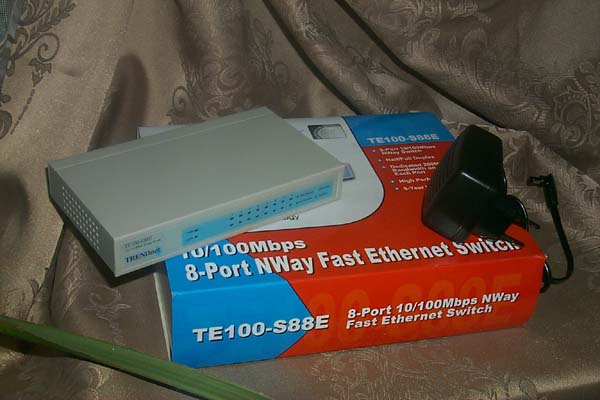 The switch comes with a power unit and a booklet with brief documentation. The documentation contains both theory on ethernet networks and practical steps of connecting the mini-switch to other devices. Now we have two indicators of the port status (one of them is of two colors), and a LOOP LED. The indicators are located on the front panel. We also have a power indicator and a network loop one. The latter notifies about traffic loopbacks in the network, i.e. when a special packet sent by the switch from one port is received by its another port. Here is the table of the indicators:
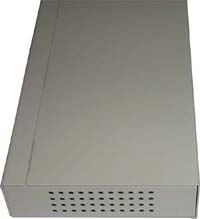 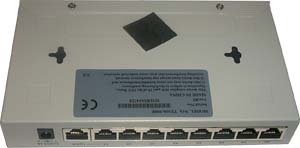 The case is metallic; it can be installed both in vertical and horizontal positions (there are rubber legs and mounting holes). The 9th connector which is combined with the first port is used as uplink. 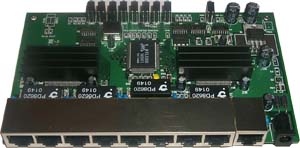 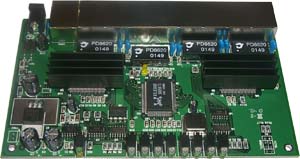 The switch is based on the 8-port 10/100 Ethernet Switch Microcontroller RTL8308B from Realtek. The 2 Mbit memory (32K x 64) working at 50 MHz is used as a buffer of ethernet packets. The memory consists of 1 KBytes pages. The table of MAC addresses contains 8K records (not more than 1K records per port), and the CAM table of 128 records is used to accelerate its access. The interface of the microcontroller ports is RMII, the transmission environment can be accessed through 2 4-port (external) transceivers RTL8204. In this case the transceivers are covered with non-removable heatsinks (soldered to the board), and most likely they are RTL8204. The switch uses store-and-forward and cut-through (optional) methods of packet commutation. The second method is used for packets not longer than 512 bytes. In the first case the packet is first transferred to the buffer, then its integrity is analyzed according to checksums and only after that its further rout is determined according to the destination address. Although this method is not the fastest, it filters traffic from distorted (false) frames. The cut-through method works faster - after reception of first several frame bytes (with a recipient's address) the switch determines its rout straight away (or it deletes it if the recipient is on the same port the frame comes from). The other bytes of this frame are directly transferred to the output port (or deleted). Of course, if the output port is busy at that time data are transferred into its buffer (the cut-through method is replaced with the store-and-forward one). Although the cut-through method provides a greater performance gain, packets are not analyzed completely (because they are not buffered in the memory), and false packets are not filtered out. That is why reliability is lower - false frames will go further. According to the datasheet the microcontroller has a lot of other things, for example:
If the meter of broadcast packets (with the MAC recipient's address FF FF FF FF FF FF) is over 64 consecutive packets, next packets will be cast away. The meter is set to zero every 800ms or if a packet of another type is received. The device sends around (every 3-5 minutes) a 64-bit broadband packet of a certain format which contains a unique identifier. A special LED notifies about a loopback ??? So that this function can work, all devices in the network must support it. Filtering and redirection of obtained frames can be based on information from a frame according to the status (whether it's on) of the port, an internal switch's configuration or VLAN configuration. Besides, the Spanning Tree (STP protocol) is supported. Doubling of frames passing through a certain switch's port to another port, for example, for traffic analyses. It is used to access 2Kbit EEPROM for storage of configuration. Apart from the standard mode (dynamic MAC addresses), there is also a mode of static MAC addresses. In the first case the switch fills in the table of MAC addresses according to information from packets coming from the ports. In the second case it's possible to associate a certain MAC address with a certain port. The respective information can be taken from the EEPROM or through the control interface. As this device doesn't contain any control functions and the documentation doesn't mention any above modes, except loop detection, I consider the other functions are not enabled in this switch. Below are the characteristics of the switch:
Test resultsSummary table The testing technique is described here. Data only in one direction coming through the port are calculated (half duplex), if the opposite is not mentioned. The speed is calculated in KB (not Kbit!). Data are transferred in 64 KBytes blocks.
I won't plot a performance diagram as there is nothing to compare with. And the diagrams of operation of the switch are here. At the maximum load of the most switch's ports the device works at its maximum throughput, but if only two ports with different transmission environments are commuted there are certain problems. It is unclear whether they are caused by the maximum load of these two ports (i.e. the device is guilty) or the testing technique is imperfect. Anyway, the testing technique will soon be expanded, and it will be possible to look deeper into the problem. From the functional standpoint everything is OK - only a port damage indicator is lacking. Two-color indicators are better than several single-color ones. An uplink port is here. The device can be installed horizontally or hung on vertical surfaces. The cable of the power unit is very short, about half a meter. It's unclear why some interesting functions of the controller the switch is based on are not enabled. On the other hand, it will result in a higher price. But the price difference is on the manufacturer's conscience. On the other hand, it's questionable whether the loop detection function is necessary. Such loopbacks can occur in big networks with a complicated topology, with channel doubling. But as a rule, they use more expensive devices. Probably, the engineers thought about it as well, that is why you can also see a mini-switch of the TE100-S88Eplus. Despite the similar names they are completely different. The TE100-S88Eplus is based on another microcontroller. It has a smaller size of the frame buffer and MAC buffer, it lacks for an uplink port and has a different structure of indicators. The company has taken a way of further cost reduction. ConclusionThis is an inexpensive mini-switch with a full set of respective functions
- it suits for home, office and average local networks. The only thing
you might need is an extender.
Write a comment below. No registration needed!
|
Platform · Video · Multimedia · Mobile · Other || About us & Privacy policy · Twitter · Facebook Copyright © Byrds Research & Publishing, Ltd., 1997–2011. All rights reserved. |